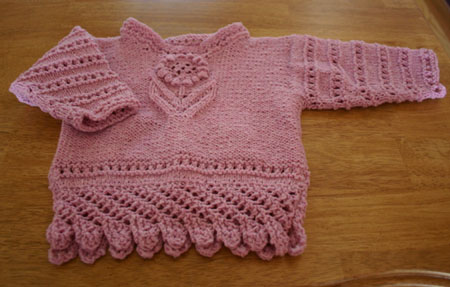Rebecca's Rose
Project Stats
| Pattern: | Adorable Knits for Tots - Lacy Sweater | Started: | 7/21/2006 |
| Yarn: | Sirdar Denim Tweed DK, color 625 | Completed: | 8/2/2006 |
| Needles: | US 6/4 mm, US 5/3.75 mm | For: | Rebecca |
August 5, 2006 - Model picture. Here's a picture of Carrie wearing the sweater. It's worth noting that I made the 6-12 month size (to gauge!) and it fits my rather average-sized 21-month-old about perfectly. I'd noticed that the patterns in this book seemed to be rather generously sized, and now that I have a model to try them on I'm sure they're a bit oversized. That's OK, though, since kids have this bizarre tendency to grow rather quickly! |
|
August 2, 2006 - Finished!  I finished sewing up the seams and hiding the ends at Sit & Knit this evening. I really love this sweater, and plan to make another in a bolder color for Carrie at some point. Things I'll do differently next time:
Sewing in the sleeves: A mini-tutorial Have you ever tried to find any reference about sewing reverse stockinette seams? How about sewing a stockinette sleeve into a reverse stockinette armhole? I couldn't find one, so I made it up as I went along. To help me when I try to do it again, I created a little mini-tutorial and took pictures along the way. This tutorial assumes you know how to do a little bit of finishing already - tapestry needle, starting at the shoulder seam, etc. I used a variation on a woven seam between stitches and rows. My favorite reference for this type of seam is The Knitter's Book of Finishing Techniques, by Nancie Wiseman. (Actually, this is a fabulous reference for making your knitting look great when you finish it!) Step 1: Put the needle between the first and second stitch at the top of the sleeve. It will follow horizontal bar behind that first stitch. Clear as mud? Here's a picture:  Step 2: The only way I could do this without distorting the stitches was to go through two rows each time. So I first put the needle through a "down" bar two stitches in from the edge, then I put it through an "up" bar one stitch in from the edge on the row below. You see the "down" bar right next to that "up" bar? That's the stitch we'll use next time.  Step 3: Repeat steps one and two until you get to the end of the seam. You will most likely have to skip rows in the armhole to make the sleeve fit properly. I counted the number of stitches at the top of the sleeve and the number of rows in the arm hole and came up with a three-to-four ratio, which is pretty common. That means for every three stitches I weave at the top of the sleeve I need to use up four rows in the armhole. In my case, on every third stitch of the sleeve I skipped a row of the armhole by going into the "down" bar on the row below the last "up" bar used.  This shows the path of the yarn for several stitches. You will want to a) use matching yarn, and b) keep an even tension without making the stitches too tight. Here's the finished seam (redone with matching yarn):  |
|
July 30, 2006 - Body down, sleeves to go.  I finished the back a few days ago, the front last night, and decided to join the shoulders and knit the neckband today before starting the sleeves. The neckband looks a little wavy, but I'm going to keep it until I block the sweater (after it's all sewn together). It might behave a bit better after that. Besides, babies heads are bigger than they look, so I don't want to make it too tight.  Here's a closeup of the flower motif (and a bit more accurate representation of the color). I don't normally like bobbles, but in this case I think they work well. Plus I figured out how to knit backwards for the five bobble stitches so I wouldn't have to keep turning my work multiple times per row. |
|
July 21, 2006 - Perfect baby sweater! My favorite kind of knitting projects are the ones where the yarn and pattern complement each other perfectly. The ones where the first gauge swatch is perfect. The ones where I want to knit "just one more row" because I can't wait to see how the pattern looks after that row. This is that kind of project. This sweater is going to be so soft and cuddly when it's done, and that's exactly what a baby sweater should be! (After all, soft and cuddly babies are even more fun to hug!) |
All images, content and design are © 2001-2006 Sarah Reilly. All rights reserved.





